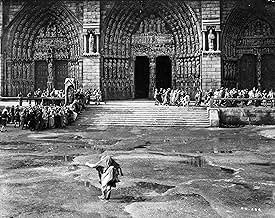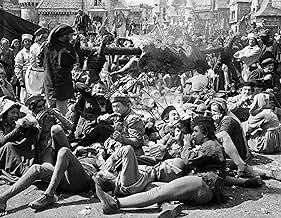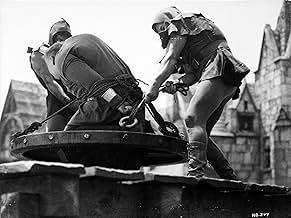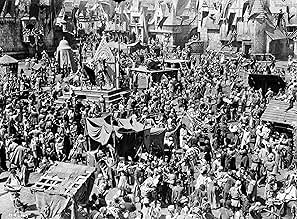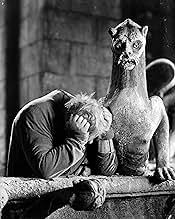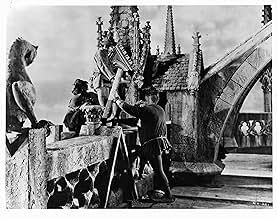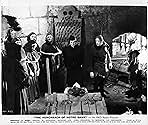NOTE IMDb
7,8/10
13 k
MA NOTE
Ajouter une intrigue dans votre langueIn 15th-century France, a gypsy girl is framed for murder by the infatuated Chief Justice, and only the deformed bellringer of Notre Dame Cathedral can save her.In 15th-century France, a gypsy girl is framed for murder by the infatuated Chief Justice, and only the deformed bellringer of Notre Dame Cathedral can save her.In 15th-century France, a gypsy girl is framed for murder by the infatuated Chief Justice, and only the deformed bellringer of Notre Dame Cathedral can save her.
- Réalisation
- Scénario
- Casting principal
- Nommé pour 2 Oscars
- 1 victoire et 2 nominations au total
Cedric Hardwicke
- Frollo
- (as Sir Cedric Hardwicke)
Helene Reynolds
- Fleur de Lys
- (as Helene Whitney)
Minna Gombell
- Queen of Beggars
- (as Mina Gombell)
Rod La Rocque
- Phillippe
- (as Rod LaRocque)
Avis à la une
The ending differs from Hugo's novel,but I guess it was necessary to bestow on the audiences a de rigueur happy end when the world situation was getting worse and worse.It' s also dubious that king Louis XI -who died in 1483- might have been aware of Christophe Colomb's plans ,because the latter only informed the king of Portugal-who refused to put up the money for his expedition- in ...1484!
These are minor squabbles.Because this movie is definitely the finest version of Hugo's classic ,much superior to the French one ,directed by Jean Delannoy(1956) with Anthony Quinn and Gina Lollobrigida.Dieterle's work is a feast for the eyes with numerous classic scenes ,very clever dialogue,superlative performances and complete mastery of the camera.
The opening-Louis XI visiting a printing house-sums up the turning of history:Gutenberg's invention will allow the knowledge and as the King watches the cathedrals ,he makes us feel that these books of stone are fast becoming a thing of the past.The Middle Ages are coming to an end,but a lot of people ,particularly the clergy do not want to lose the power they have on the populace.When Frollo sentences Esmeralda to death,because of his sexual desire,he puts the blame on the devil.He's a man of the past,diametrically opposite to Gringoire,who epitomizes modernity,and who understands the power of the pamphlet which the printing increases tenfold.
Charles Laughton is by far the best Quasimodo that can be seen on a screen:he's so extraordinary that he almost turns the happy end into a tragedy!He gets good support from a moving and extremely beautiful O'Hara as Esmeralda and from Harwicke as Frollo.
Peaks:the fools day,the cour des miracles -maybe showing some influence by Browning's "freaks"-,all the scenes in the cathedral.Dieterle is on par with the most demanding directors all along his movie:the movements in the crowd are stunning,breathtaking,often filmed from the church towers.Humor is not absent either:Gregoire's eventful night in the cour des Miracles is colorful and funny and scary all at once.
A monument,like the cathedral itself.
These are minor squabbles.Because this movie is definitely the finest version of Hugo's classic ,much superior to the French one ,directed by Jean Delannoy(1956) with Anthony Quinn and Gina Lollobrigida.Dieterle's work is a feast for the eyes with numerous classic scenes ,very clever dialogue,superlative performances and complete mastery of the camera.
The opening-Louis XI visiting a printing house-sums up the turning of history:Gutenberg's invention will allow the knowledge and as the King watches the cathedrals ,he makes us feel that these books of stone are fast becoming a thing of the past.The Middle Ages are coming to an end,but a lot of people ,particularly the clergy do not want to lose the power they have on the populace.When Frollo sentences Esmeralda to death,because of his sexual desire,he puts the blame on the devil.He's a man of the past,diametrically opposite to Gringoire,who epitomizes modernity,and who understands the power of the pamphlet which the printing increases tenfold.
Charles Laughton is by far the best Quasimodo that can be seen on a screen:he's so extraordinary that he almost turns the happy end into a tragedy!He gets good support from a moving and extremely beautiful O'Hara as Esmeralda and from Harwicke as Frollo.
Peaks:the fools day,the cour des miracles -maybe showing some influence by Browning's "freaks"-,all the scenes in the cathedral.Dieterle is on par with the most demanding directors all along his movie:the movements in the crowd are stunning,breathtaking,often filmed from the church towers.Humor is not absent either:Gregoire's eventful night in the cour des Miracles is colorful and funny and scary all at once.
A monument,like the cathedral itself.
One of the great Hollywood films of 1939, this adaptation of Victor Hugo's novel is sumptuously put together, boasting a fine script, tight direction by German export William Dieterle, and a cast who fit their parts perfectly: Charles Laughton superb as the maligned Quasimodo; Maureen O'Hara in an early role as gypsy Esmeralda; Cedric Hardwicke as the pious Frollo; and Harry Davenport as the king, Louis XI.
The story is a version of Beauty and the Beast set within the confines of Notre Dame Cathedral and the dirt-strewn and prejudiced streets of Paris. Quasimodo, physically repulsive and deafened by the bells of the cathedral, nevertheless finds it in his childish heart to love the beautiful Esmeralda and to sacrifice his sanctuary for her. She however only has eyes for the dashing Gringoire (Edmond O'Brien) who she saves from the justice of the beggar thieves.
It is Laughton's performance that holds this film together - truly one of the greatest screen actors, capable of portraying pathos like no other. Contrast this film role with his Henry VIII or Captain Bligh and you begin to get an idea of his impressive range.
The story is a version of Beauty and the Beast set within the confines of Notre Dame Cathedral and the dirt-strewn and prejudiced streets of Paris. Quasimodo, physically repulsive and deafened by the bells of the cathedral, nevertheless finds it in his childish heart to love the beautiful Esmeralda and to sacrifice his sanctuary for her. She however only has eyes for the dashing Gringoire (Edmond O'Brien) who she saves from the justice of the beggar thieves.
It is Laughton's performance that holds this film together - truly one of the greatest screen actors, capable of portraying pathos like no other. Contrast this film role with his Henry VIII or Captain Bligh and you begin to get an idea of his impressive range.
10llltdesq
The best of the many versions of The Hunchback of Notre Dame, for my money, is this one, although Lon Chaney's is a close second. Despite a Hollywood tendancy to change the novel's ending so as not to depress the cash customers (although, pray tell, if you're going to change the ending, why does no one ever see Quasimodo sailing off to Tahiti with the girl? Rule # 1: strong, handsome poets beat out disfigured cripples every time, even if they're heroes. This is more true in real life than in the movies. Take my word for this, I know from painful experience *sigh*)
Charles Laughton is exceptional and Maureen O'Hara would make any man swoon and is perfect for the part of Esmerelda. The support includes the usual suspects-Thomas Mitchell, Harry Davenport and many other familiar character actors. Strike up the band and start the parade. Thunderous applause. Most highly recommended.
Charles Laughton is exceptional and Maureen O'Hara would make any man swoon and is perfect for the part of Esmerelda. The support includes the usual suspects-Thomas Mitchell, Harry Davenport and many other familiar character actors. Strike up the band and start the parade. Thunderous applause. Most highly recommended.
Charles Laughton's boisterous portrayal of Quasimodo and Maureen O'Hara's charm as Esmerelda are two of the things that make this version of "The Hunchback of Notre Dame" a fine production that still works very well. Most of the versions of the story have been at least watchable, because the Victor Hugo novel provides so much good material to work with, much of it well-suited for cinema. This adaptation, though, is one of the best at making good use of what it offers.
It's interesting to compare this picture with the 1923 Lon Chaney version - not for the sake of ranking them, since both are fully worthy of attention in their own right, but because they offer somewhat different strengths, and because they emphasize somewhat different aspects of the story.
Chaney and Laughton are both quite effective as Quasimodo, each giving an interpretation of the character that corresponds to the actor's skills. Laughton brings out Quasimodo's feelings and perspective quite well. In this version, for example, the flogging scene is longer and more detailed, and it is one of Laughton's most effective scenes. Chaney is particularly good at reacting to the other characters and their actions. Both give the character a distinctive and memorable look.
O'Hara is also one of this adaptation's strengths. Patsy Ruth Miller was good in the Chaney version, but O'Hara has the advantage of spoken dialogue, and she makes the character of Esmerelda her own.
While the Chaney version especially emphasized the atmosphere, this one has quite a bit of action. The tumultuous climactic sequences are done quite well, and they leave a vivid impression. Overall, this is a very satisfying adaptation of the fine classic novel.
It's interesting to compare this picture with the 1923 Lon Chaney version - not for the sake of ranking them, since both are fully worthy of attention in their own right, but because they offer somewhat different strengths, and because they emphasize somewhat different aspects of the story.
Chaney and Laughton are both quite effective as Quasimodo, each giving an interpretation of the character that corresponds to the actor's skills. Laughton brings out Quasimodo's feelings and perspective quite well. In this version, for example, the flogging scene is longer and more detailed, and it is one of Laughton's most effective scenes. Chaney is particularly good at reacting to the other characters and their actions. Both give the character a distinctive and memorable look.
O'Hara is also one of this adaptation's strengths. Patsy Ruth Miller was good in the Chaney version, but O'Hara has the advantage of spoken dialogue, and she makes the character of Esmerelda her own.
While the Chaney version especially emphasized the atmosphere, this one has quite a bit of action. The tumultuous climactic sequences are done quite well, and they leave a vivid impression. Overall, this is a very satisfying adaptation of the fine classic novel.
Though the French have done many versions of Victor Hugo's celebrated classic, this version starring Charles Laughton has certainly stood the test of time and is the best known and loved in the English speaking world.
Lon Chaney, Sr. did an acclaimed silent version of The Hunchback of Notre Dame and Laughton was following a great tradition. And he did it in the manner of Chaney, almost without dialog. Not that Hugo wrote too much dialog for Quasimodo in his story, but except for his time with Esmerelda in the tower after he rescues her, Laughton is almost speechless in the film. Of course his character in addition to being deformed is also deaf from the ringing of those cathedral bells.
Quasimodo born deformed as he was, was left as an orphan on the steps of the Notre Dame cathedral in medieval Paris. Raised in the sheltered atmosphere of the church, he derives some joy in his duties as the bell ringer in the tower. His mentor is the brother of the archbishop played by Cedric Hardwicke and the archbishop is Walter Hampden. Quasimodo's life is useful, but without love.
But Laughton is crushing out on Esmerelda the gypsy girl played by Maureen O'Hara in her American screen debut. Problem is that Hardwicke is also getting hot and bothered by her.
Hardwicke's role is the second best acted in the film next to Laughton's. He's a man with shall we say some issues. He's purportedly committed to the church and it's celibacy requirements. But Dr. Freud wasn't around back in the day of Louis XI to tell us about sex drives. Hardwicke's desires mean only one thing, Esmerelda has to have bewitched him. When he kills Alan Marshal who is also interested in Maureen and looks like he's about to round third so to speak, the blame goes on Maureen.
What I like about the story is how the lives of two very ordinary people, Quasimodo and Esmerelda, become the focal point for a whole lot of religious and political issues of the day. The church, the peasants, the just developing middle class, and the nobility all have an agenda as far as the Esmerelda murder case is going. The only agenda poor Quasimodo has is he's in love with her.
Maureen O'Hara who was a discovery of Charles Laughton back in the United Kingdom was pushed by Laughton for the role of Esmerelda and traveled with him to America to play the part. She was grateful to him ever afterwards for any career she had and can't praise him enough for getting RKO to sign her.
Harry Davenport probably plays the most benign Louis XI ever put on film. It sure is a far cry from Basil Rathbone in If I Were King or Robert Morley in Quentin Durward. He plays him like the kindly grandfather he usually plays on screen.
Thomas Mitchell as Clopin the king of beggars and Edmond O'Brien as Gringoire the poet are two other significant roles. O'Brien gets his first substantial role on screen in The Hunchback of Notre Dame and this was a banner year for Thomas Mitchell. In 1939 he was also in Mr. Smith Goes to Washington, Gone With the Wind and Stagecoach for which he won Best Supporting Actor. He could have though for any one of these films.
When all is said and done though the film belongs to Charles Laughton who was the screen's best portrayer of tortured humanity. Even beneath all of Bud Westmore's grotesque make-up we can feel his anguish. He's not a stupid man Quasimodo, he knows how repulsive he is to most of the human race. He's childlike though, something like Peter Sellers in Being There, another character raised in a secluded atmosphere.
To see Charles Laughton at the top of his game in my humble opinion one has to see The Hunchback of Notre Dame.
Lon Chaney, Sr. did an acclaimed silent version of The Hunchback of Notre Dame and Laughton was following a great tradition. And he did it in the manner of Chaney, almost without dialog. Not that Hugo wrote too much dialog for Quasimodo in his story, but except for his time with Esmerelda in the tower after he rescues her, Laughton is almost speechless in the film. Of course his character in addition to being deformed is also deaf from the ringing of those cathedral bells.
Quasimodo born deformed as he was, was left as an orphan on the steps of the Notre Dame cathedral in medieval Paris. Raised in the sheltered atmosphere of the church, he derives some joy in his duties as the bell ringer in the tower. His mentor is the brother of the archbishop played by Cedric Hardwicke and the archbishop is Walter Hampden. Quasimodo's life is useful, but without love.
But Laughton is crushing out on Esmerelda the gypsy girl played by Maureen O'Hara in her American screen debut. Problem is that Hardwicke is also getting hot and bothered by her.
Hardwicke's role is the second best acted in the film next to Laughton's. He's a man with shall we say some issues. He's purportedly committed to the church and it's celibacy requirements. But Dr. Freud wasn't around back in the day of Louis XI to tell us about sex drives. Hardwicke's desires mean only one thing, Esmerelda has to have bewitched him. When he kills Alan Marshal who is also interested in Maureen and looks like he's about to round third so to speak, the blame goes on Maureen.
What I like about the story is how the lives of two very ordinary people, Quasimodo and Esmerelda, become the focal point for a whole lot of religious and political issues of the day. The church, the peasants, the just developing middle class, and the nobility all have an agenda as far as the Esmerelda murder case is going. The only agenda poor Quasimodo has is he's in love with her.
Maureen O'Hara who was a discovery of Charles Laughton back in the United Kingdom was pushed by Laughton for the role of Esmerelda and traveled with him to America to play the part. She was grateful to him ever afterwards for any career she had and can't praise him enough for getting RKO to sign her.
Harry Davenport probably plays the most benign Louis XI ever put on film. It sure is a far cry from Basil Rathbone in If I Were King or Robert Morley in Quentin Durward. He plays him like the kindly grandfather he usually plays on screen.
Thomas Mitchell as Clopin the king of beggars and Edmond O'Brien as Gringoire the poet are two other significant roles. O'Brien gets his first substantial role on screen in The Hunchback of Notre Dame and this was a banner year for Thomas Mitchell. In 1939 he was also in Mr. Smith Goes to Washington, Gone With the Wind and Stagecoach for which he won Best Supporting Actor. He could have though for any one of these films.
When all is said and done though the film belongs to Charles Laughton who was the screen's best portrayer of tortured humanity. Even beneath all of Bud Westmore's grotesque make-up we can feel his anguish. He's not a stupid man Quasimodo, he knows how repulsive he is to most of the human race. He's childlike though, something like Peter Sellers in Being There, another character raised in a secluded atmosphere.
To see Charles Laughton at the top of his game in my humble opinion one has to see The Hunchback of Notre Dame.
Le saviez-vous
- AnecdotesFor the scene in which Quasimodo is whipped, Charles Laughton instructed an assistant director to twist his ankle outside of camera range so he would really be in pain. Even through the heavy hump and rubber body suit, he felt every lash and often came home badly bruised. Before the 16th take, director William Dieterle whispered to him, "Now, Charles, listen to me. Let's do it one more time, but this time I want you . . . I want you to suffer." According to Laughton's wife, Elsa Lanchester, the actor never forgave him for that.
- GaffesThe cathedral is shown as having a full flight of steps up to the front doors. Notre Dame has always been more or less level with the square (le Parvis).
- Citations
[Last lines]
Quasimodo, the bell-ringer: [to one of the stone gargoyles] Why was I not made of stone - like thee?
- Crédits fousPROLOGUE: "With the end of the 15th Century, the Middle Ages came to a close. Europe began to see great changes. France, ravaged by a hundred years of war, at last found peace. The people under Louis XI felt free to hope again --- to dream of progress. But superstition and prejudice often stood in the way, seeking to crush the adventurous spirit of man."
- Versions alternativesAlso available in a computer colorized version.
- ConnexionsEdited into The Clock (2010)
- Bandes originalesAve Maria
(1572) (uncredited)
Music by Tomás Luis de Victoria
Sung by mixed chorus during opening credits
Meilleurs choix
Connectez-vous pour évaluer et suivre la liste de favoris afin de recevoir des recommandations personnalisées
- How long is The Hunchback of Notre Dame?Alimenté par Alexa
- What is 'The Hunchback of Notre Dame' about?
- Is "The Hunchback of Notre Dame" based on a book?
- In what year is the story set?
Détails
- Date de sortie
- Pays d’origine
- Site officiel
- Langue
- Aussi connu sous le nom de
- El jorobado de Nuestra Señora de París
- Lieux de tournage
- Société de production
- Voir plus de crédits d'entreprise sur IMDbPro
Box-office
- Budget
- 1 800 000 $US (estimé)
- Durée1 heure 56 minutes
- Couleur
- Rapport de forme
- 1.37 : 1
Contribuer à cette page
Suggérer une modification ou ajouter du contenu manquant



